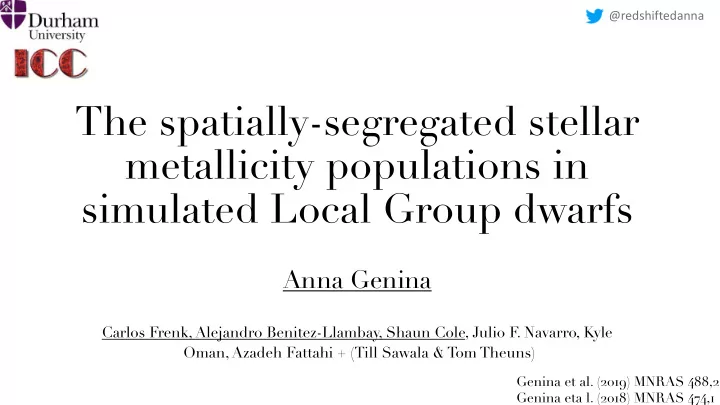

@redshiftedanna The spatially-segregated stellar metallicity populations in simulated Local Group dwarfs Anna Genina Carlos Frenk, Alejandro Benitez-Llambay, Shaun Cole, Julio F . Navarro, Kyle Oman, Azadeh Fattahi + (Till Sawala & Tom Theuns) Genina et al. ( 2019 ) MNRAS 488 , 2 Genina eta l. ( 2018 ) MNRAS 474 , 1
MR Two populations in Sculptor and Fornax: A centrally-concentrated • MP metal-rich population An extended metal-poor • population Can exhibit different • kinematics E.Tolstoy et al. arXiv: 0411029 ( 2004 ) G.Battaglia et al. arXiv: 0608370 ( 2006 ) G.Battaglia et al. arXiv: 0802 . 4220 ( 2007 ) but also see D.Kawata et al ( 2006 ) arXiv: 0509402
APOSTLE simulations • EAGLE model • 5 high-resolution volumes 4 (m gas = 0 . 5 - 0 . 8×10 Msol ) • Milky-Way and Andromeda analogues selected to fit Local Group constraints Sawala T. et al. ( 2016 ) arXiv: 1511 . 01098 Fattahi A. et al. ( 2016 ) arXiv: 1507 . 03643
Defining the number of populations 1 . Fit metallicity histograms with a Gaussian Mixture Model + calculate AIC 2 . Count the number of peaks 3 . Number of peaks = Number of populations Genina et al. ( 2019 ) arXiv: 1812 . 04839
The Sample APOSTLE does well on the • mass-metallicity relation We find two populations along • the entire mass range Dwarfs with two populations • make up nearly half of all dwarfs and this fraction is approximately the same across all mass bins A.McConnachie ( 2012 ) arXiv: 1204 . 1562 E.N.Kirby et al. ( 2013 ) arXiv: 1310 . 0814 Genina et al. ( 2019 ) arXiv: 1812 . 04839
Isolated dwarfs Spatial segregation is related to mergers See also Benitez-Llambay et al. ( 2015 ) arXiv: 1405 . 5540 Benitez-Llambay et al. ( 2016 ) arXiv: 1511 . 06188 Revaz & Jablonka ( 2018 ) arXiv: 1801 . 0622 Mergers can be the cause of the formation of two populations in low and high mass dwarfs. Signs of a merger have been seen in Fornax and Andromeda II. Amorisco et al. ( 2014 ) arXiv: 1402 . 5142 del Pino et al. ( 2015 ) arXiv: 1509 . 05336 del Pino et al. ( 2017 ) arXiv: 1611 . 08446 Genina et al. ( 2019 ) arXiv: 1812 . 04839
Genina et al. ( 2019 ) arXiv: 1812 . 04839 https://youtu.be/obgdLxd3vq0
Satellite dwarfs 2 . Interactions 1 . Mergers Lookback time (Gyr) 3 . At pericentre with filaments Genina et al. ( 2019 ) arXiv: 1812 . 04839
Star formation near pericentre Genina et al. ( 2019 ) arXiv: 1812 . 04839 https://youtu.be/TmRwi6iaPls
Ram pressure induced star formation See also Wright et al.( 2019 ) arXiv: 1802 . 03019 Genina et al. ( 2019 ) arXiv: 1812 . 04839 https://youtu.be/HAU_kcjrgGw
Mass dependence of the mechanisms The prevalence of the merger scenario • dependent on mass and is the most common mechanism in isolated dwarfs Forming a metal-rich population by • passing through pericentre is the dominant mechanism in satellites. Fornax-mass galaxies likely formed their • metal-rich stars by passing through pericenter, unless never reached that stage Best Sculptor analogue formed through a • merger, but sample is small in this mass range Genina et al. ( 2019 ) arXiv: 1812 . 04839
Can we tell the mechanisms apart? Mostly not! But metallicity distributions can be telling… Isolated (mostly mergers) Satellite (mostly host influence) More abundant metal-poor population More abundant metal-rich population because gas is stripped at late times
What can we learn from two populations? MP MR Define the mass slope: Wolf et al. ( 2010 ) arXiv: 0908 . 2995 M.Walker & J.Penarrubia ( 2011 ) arXiv: 1108 . 2404
Genina et al. ( 2018 ) arXiv: 1707 . 06303 see also Kowalczyk et al. ( 2013 ) arXiv: 1212 . 3438
Genina et al. ( 2018 ) arXiv: 1707 . 06303 We find satellites and fields with different ellipticities of the metal-rich and the metal-poor populations. This difference occurs across the entire range of masses explored.
Genina et al. ( 2018 ) arXiv: 1707 . 06303 (cuspy) (more cored) (accuracy) (estimated slope) • The estimators do well on average, but ~ 20 % of the time we infer a core-like profile, when in reality there is a cusp. • Problematic dwarfs are ones where the the two populations have different ellipticity and/or are misaligned
Questions? And thanks for listening!
Need more stars and data beyond ~ 3 Rh (difficult to achieve though) Fraction of galaxies correctly identified as having two populations Expect 1 - 3 galaxies within the mass range explored
We apply our method to find two populations in Sculptor
The origin of metallicity distribution bimodality The separation of the metallicity peaks depends on how long the galaxy had to form its stars How quickly do stars form in each metallicity bin. Split of two populations (dip in the distribution) happens after an intense episode of star formation followed by a drop in star formation
The gas is enriched within the galaxy! Position of gas particles when they were sufficiently enriched to form a metal- rich stellar particle
We replicate the z= 0 HI masses in APOSTLE
Accretion matters for satellites too!
Recommend
More recommend